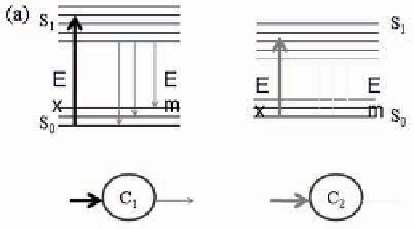Biomedical Engineering Reference
In-Depth Information
transfer of the energy of the excited donor dipole. In the dimensions
of noble metal nanoparticles (ca. 10 nm), the energy gap between
the ground and the irst excited electronic states of free electrons
on the surface of nanoparticles often its the wavelength range of
visible light. In other words, the resonance frequencies of noble
metal nanoparticles can match the emission frequencies of various
donor luorophores in the visible light range.
(A)
(B)
Figure 7.2
The mechanism of Förster resonance energy transfer process.
(A) Two compounds, C
1
and C
2
, are far away. They need light
of speciic wavelength for excitation (blue and green thick
arrows), after relaxation, emission lights will appear (green
and yellow thin arrows). (B) When C
1
and C
2
are close enough
in a distance about 10 nm or less, they form a donor-acceptor
pair. By exciting the donor, FRET occurs (grey dashed arrow).
Acceptor receives the energy, then be excited (grey arrow),
after relaxation, the emission light of the donor-acceptor pair
comes mostly from the acceptor (yellow arrows). See also
Color Insert.
This interaction between two transition dipoles becomes
signiicant only when two dipoles are relatively close, typically
10 nm or less. Since the interaction between the induced dipole
and induced dipole is inversely proportional to the sixth power of





Search WWH ::

Custom Search